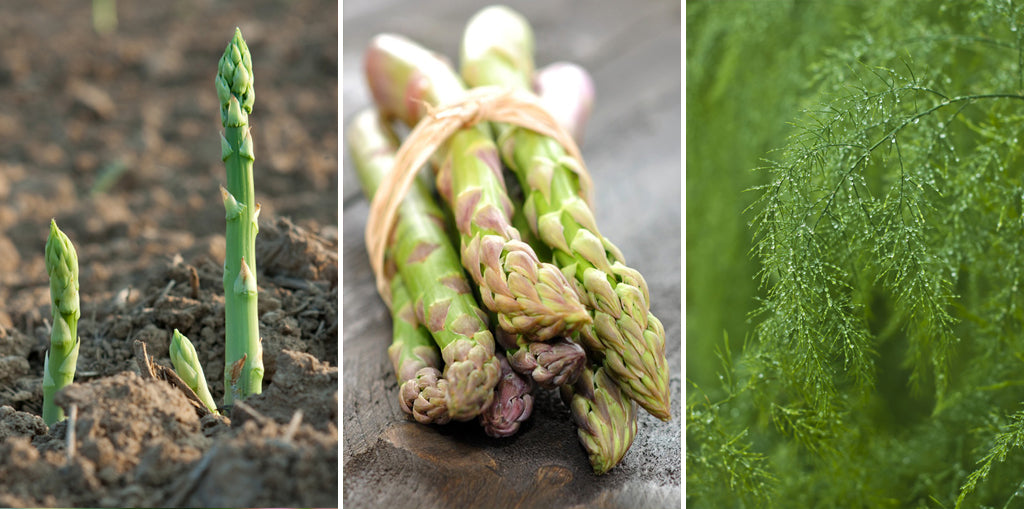asparagus
With a little patience, this luxurious vegetable can grow in your garden, too. Provided you give it the necessary space and allow the asparagus three years to mature before the first harvest. It's worth the effort, because you won't find these delicious spears fresher anywhere!

Planting time – When is best?
You can grow asparagus from seed in the spring. It's quicker if you plant pre-grown root pieces. Asparagus is planted from March to May, as soon as temperatures rise.
Asparagus cultivation – How does it work?
Dig a 30 cm wide planting trench. For green asparagus, 10 cm is sufficient. Plant the shallow rootstocks 50 cm apart so that the roots can spread in all directions. Then fill with soil and mix in organic fertilizer in the form of mature compost or aged manure. In the second year after planting, fertilize again in spring to encourage vigorous plant development. Create a 30-40 cm high soil mound around the plants. This will whiten the asparagus. With green asparagus, this work is eliminated. In the third year, you can finally harvest!
Location – Where is best?
Asparagus prefers a sunny location and light, nutrient-rich soil. Permeable, sandy soil warms up particularly quickly in spring, providing the best conditions for optimal growth.
Care – What needs to be done?
Especially in the first year of planting, make sure the young asparagus plants don't dry out. Water them regularly. This also applies after harvest. Since asparagus doesn't like to be crowded or shaded, regularly weed the asparagus beds. In the fall, provide a nutrient boost with organic fertilizer. With proper care, you can harvest for decades.
Harvest – What should you consider?
The asparagus harvest begins – depending on the weather – around the end of April and traditionally lasts until June 24th (St. John's Day). After that, the plants need a regeneration period to gather strength for the next harvest year. Asparagus grows quickly in warm weather, so harvest the asparagus every few days with a long asparagus shovel. You can tell which stalks are ready by the small cracks that form in the soil. It's best to expose the soil all around the asparagus. This allows you to shovel more precisely without damaging adjacent stalks or the rootstock. Grasp the asparagus head and run the shovel down the length of the stalk and cut it off. Cover freshly picked asparagus with a cloth to prevent it from drying out. And don't forget to close the holes in the soil!
Mixed culture – What are good neighbors?
Asparagus goes well with beans, dill, peas, cucumbers, kohlrabi, parsley, lettuce and marigold.
Botany – What kind of plant is this?
Asparagus is a perennial herb in which only the rootstock (the rhizome) survives the winter. In spring, this produces several shoots, which are harvested as asparagus. Biologically speaking, asparagus is therefore a stem offshoot of the asparagus plant. After harvesting, the remaining shoots form the feathery asparagus greens or asparagus leaves. The female plants later bear red berries. These are poisonous to humans but very popular with birds – especially the fruit flesh. The seeds are excreted undigested, thus contributing to the spread of the asparagus. This is how wild asparagus develops.
The genus Asparagus comprises approximately 300 species, of which over 100 are distributed in the Mediterranean countries, the rest in Asia (East Asia, Central Asia, East India) and warm extratropical regions. Only one species, Asparagus officinalis, is found in Europe.
Cultural history – How did asparagus come to us?
The first cultivated asparagus originates from wild asparagus, which was already valued as a vegetable and medicinal plant in ancient Rome and by the Greeks. The Greek physician Hippocrates of Kos (c. 460-370 BC) was aware of its diuretic properties. Whether the Romans brought asparagus to Germany is not known for sure. While asparagus cultivation was already widespread in France and England at the beginning of the 16th century, the first asparagus beds were not planted in Germany until the middle of that century. The first documented asparagus field in Germany was planted in 1565 in the Lustgarten in Stuttgart.
TEXT: Martina Raabe







































































































